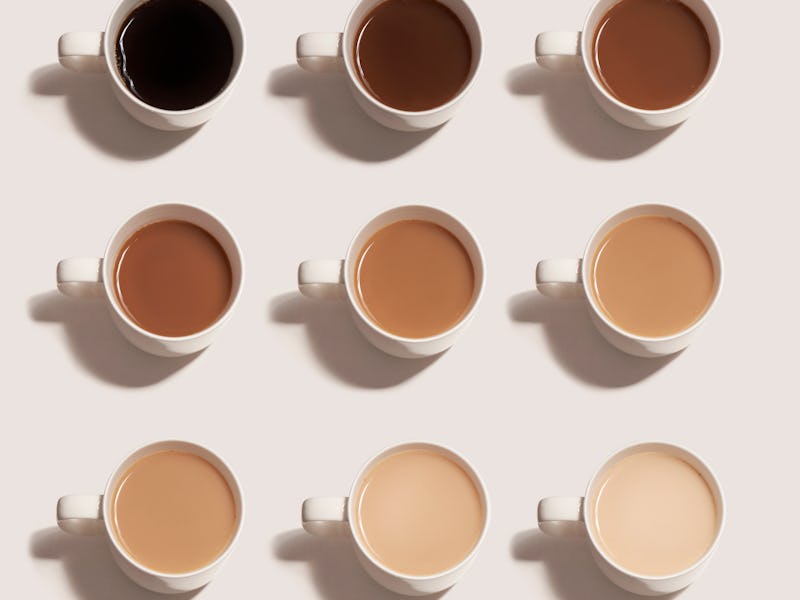Can you drink coffee without staining your teeth? Dentists reveal tricks that actually work
There are ways to help prevent the stains that accompany your coffee addiction.

If you missed a dentist appointment or two over the course of the pandemic, you may have noticed more stains on your teeth than normal. That can lead to self-consciousness, which is one of the reasons teeth whitening products are such a big business. In 2021, the global industry for teeth whitening products reached $5.2 billion.
While those products can certainly whiten teeth, they can also be pricey and leave your teeth uncomfortably sensitive. A more wallet-friendly option is simply to try to prevent stains from occurring in the first place. Inverse spoke to two dentists about what causes stained teeth and ways you can mitigate or prevent them.
The two types of tooth stains
Daniel Adelpour is a dentist in California who specializes in cosmetic and restorative dentistry. He explains that there are two types of stains: intrinsic and extrinsic.
“Extrinsic stains affect the outer layer of your tooth called enamel,” Adelpour tells Inverse. “These stains are usually formed from eating or drinking foods that are dark in color, or foods that have tannins such as red wine and coffee.”
Intrinsic stains, on the other hand, affect an inner layer of your tooth called dentin. These strains are not formed by things we eat but instead by “certain medications, aging, and dental history, such as the tooth not forming correctly, or previous fillings or root canal procedures that leave the tooth dead inside and therefore discolored,” he says.
What are the biggest teeth-staining offenders?
Angela Abernathy, a restorative and cosmetic dentist in Manhattan, tells Inverse that “extrinsic stains are usually caused by what we consume on a daily basis. These are things such as coffee, tea, red wine, curry, turmeric, betel nuts, tobacco products, and even certain prescription mouth rinses, specifically chlorhexidine gluconate.”
In other words, Adelpour adds, “if it can stain a white t-shirt, it can stain your teeth.”
And while the tea drinkers among us might like to think that something like green tea isn’t as likely to stain your teeth as coffee, Abernathy says that’s not correct.
“If it can stain a white t-shirt, it can stain your teeth.”
“Black or green tea is more staining than coffee because of the higher amount of tannic acid that is found in tea. Green tea is a little less staining [than black tea], but it will stain teeth over time.”
How can you prevent stained teeth?
Abernathy and Adelpour stress that the best way to prevent extrinsic stains is to limit or entirely eliminate the consumption of foods, drinks, or tobacco products that stain teeth. However, they acknowledge that might not be entirely realistic.
“Everyone loves their morning coffee or glass of wine at dinner,” Adelpour says.
But if you can’t quit your coffee addiction, there are ways to help prevent the stains that come along with it. In addition to regular brushing, flossing, and regular visits to the dentist for cleanings, one way to limit the damage certain beverages can do is to drink water after the beverage and swish it around in your mouth before swallowing, the dentists advise.
Using a straw to consume beverages that are likely to stain teeth, such as iced tea or coffee, can reduce the amount of time the drinks are around your teeth, which can help prevent stains, Abernathy says.
“When it comes to extrinsic stains of the enamel, a nice cleaning at the dentist will typically get rid of those types of stains and still leave your enamel unharmed,” Adelpour says.
He also advises avoiding “aggressive ‘whitening’ toothpastes, especially toothpastes that contain charcoal, as these are often too abrasive and can lead to wearing down your enamel and other problems such as gingival recession.”
Avoid aggressive ‘whitening’ toothpastes, especially toothpastes that contain charcoal, as these are often too abrasive and can lead to wearing down your enamel and other problems such as gingival recession.
Always make sure the toothpaste you are using has the American Dental Association seal of approval.
Chlorhexidine rinses, germicidal mouth rinses sometimes used to treat conditions like gingivitis, are “great for killing bacteria that causes gum disease, but it can cause brown stains, and it is recommended to not consume anything for 30 mins after use,” Abernathy says. If you’ve been prescribed a chlorhexidine mouth rinse and are concerned about teeth staining, you may want to consult with your dentist or hygienist to find an alternative that will not stain the teeth.
Stains from betel nuts, which are consumed in some cultures, are “extremely difficult to remove and must be done professionally by a dentist or hygienist,” Abernathy says. “Curry and turmeric — especially turmeric — stains are also difficult to remove or prevent. I recommend that my patients with a lot of staining come in more often for cleanings,” noting that the twice-a-year recommendation “came from an old toothpaste jingle and has no real science behind it.” Professional tooth whitening can also help with stains.
The dentists’ recommendations largely apply to extrinsic stains — the kinds that result from certain foods or drinks — because “they are largely developmentally based or chemically altered parts of your dentin,” Adelpour says.
While swishing water after drinking red wine or using a straw for iced coffee can help prevent stains on your teeth, there’s no substitute for regular dentist visits. Not only can a dentist help with cosmetic issues like stains, but they’re also vital for maintaining good oral health generally.